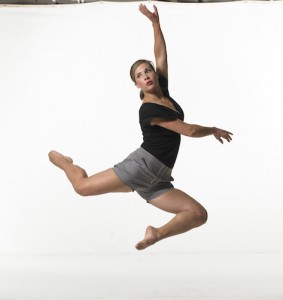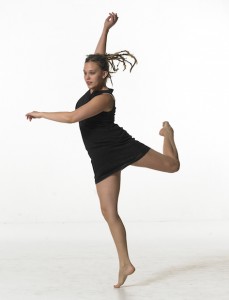Last week we ran an interview with Margi Cole about choreography and her upcoming showcase, which features dancers from her company making their own dances. Today we highlight both the dancer and the choreographer, to give you a closer look at the overall process.
Kaitlin Bishop is the choreographer here, and she has created a solo delving into the basic human emotion of sadness. The piece looks at how early childhood experiences with sadness dictate its existence (or lack thereof) in our adult lives and how we react to it, in it and through it.

Here are some of Kaitlin’s thoughts on the piece….
Where did the idea for this piece come from?
I think the idea for this piece has been slowly incubating in the back of my brain for a few years now. The work I’ve choreographed in college and for TDC is always rooted in a journey, be it a journey I’ve completed or a journey I’m currently experiencing. I’ve always been a very introspective person, keeping a journal even as a very young child, so thinking about and acknowledging my feelings is second nature, however, as I’ve gotten older, and have recently gotten married, I’m now not only recognizing emotional states but I’m really starting to analyze them, their range and scope, and question the true cause of them – if there is one. Sharing my daily life with another person has really been pretty fascinating in that I now have a witness to my daily emotional experience – someone who makes observations and asks questions, in a way forcing me to articulate how my internal thoughts & emotions manifest themselves externally.
Is there a reason you chose to make it a solo piece?
The idea and experience behind this piece is so personal, not just for me, but for Maggie, and essentially for every person who has ever experienced feeling sad. Everyone relates to sadness (and its varying degrees) so differently. Sadness is such a singularly personal and internal experience and journey, I couldn’t imagine attempting to capture that in anything other than a solo piece. When I watch dance, I’m always looking at and responding to the relationship between the dancers. When I see a (good) solo, I see a person existing in space, inhabiting their experience for me bear witness. I think if I added another person to that space, it would become about something else – not just this single person’s experiences within herself.
What was it like to choreograph this work?
It’s actually been very energizing and exciting in the process so far. Maggie and I have such an open and honest dialogue about our respective experiences of sadness (and causes thereof) in our lives, and also through this process, how ideas are being manifested physically and visually, etc. It’s pretty exciting to go into a rehearsal and have absolutely no reservations or fear about what we might discover, either in the work or in ourselves.
Can you explain your process?
We started rehearsing in the beginning of March, but we started discussing the piece in January. I had a (long) list of questions I created based on my own experiences throughout my life, questions I’ve been asked myself, conversations we’ve had in the past, etc, for Maggie to answer that served as the jumping off point for this whole process.
From there, we just kept making observations and asking more questions and having more e-mail conversations, until I went back and extrapolated the ideas, phrases, and stories that really resonated with me. Bringing those discussions into the movement invention process has involved a lot of improvisation and movement investigation, teaching each other our movement vocabulary, stripping it down, and then building it back up. I create work similarly to how I write: with the overall framework of what I want to convey set, and then allowing the movement vocabulary to develop and flesh out the experience, making changes and going in new directions as the process and underlying ideas dictate.
Prior to this—what experience did you have with choreographing dance?
Having grown up teaching and choreographing dance in a typical studio setting (jazz, tap, ballet, etc), I graduated college a little burnt out on the idea and not really interested in pursuing my own choreographic opportunities to any great extent. Working in a collaborative environment with The Dance COLEctive really satisfied that urge for the past several years too. I created a work for last year’s COLEctive Notions concert when I challenged myself to do something that scared the crap out of me and had such a great time, it really seemed to light a little fire in me. Plus, it would just be silly to pass up the opportunity and resources that Margi’s giving us in this process. It’s incredibly rare to be given the space, time, and energy that Margi’s giving us to do this.
What was it like to choreograph for Maggie?
Choreographing for Maggie is 90% of the fun. We have such a special friendship, and that has really served as an incredible foundation for the piece we’re creating together. To be able to so openly delve into our thoughts, feelings, and experiences and then really explore a physical embodiment of those discussions has been incredible. There’s no one I trust with this piece more than Maggie, and it’s actually been a great learning experience for me as well, to listen to her own thought processes and ideas as we’ve investigated movement ideas and such. It just adds to the personal reward of creating when there’s so much reciprocity with the dancer embodying the work, especially given the sensitive and personal nature of the subject matter. I don’t think there’s any fear or insecurity in this process for either of us, which makes it all the more exciting.
How would you characterize the entire experience?
So far, the experience of creating this piece has been amazing. The discussions, the discoveries, the challenges, have been so fun. What I think will be interesting (and slightly scary) to see will be what it’s like to have this piece viewed by others. Right now, Maggie and I have this very open and safe space we’ve created for each other in this process, and I’m very aware of the fact that at some point, others will see this, will see me, essentially, and the ideas behind this work are so incredibly personal for me, it’s more than a little terrifying to have it available for public consumption.
And now for a perspective from the other side…the dancer, Maggie Koller, talks about what it was like to work with Kaitlin…

What did you think of the choreographic process for this solo piece?
I found the process to be very interesting! When Kaitlin views dance, she finds herself more appreciative of work that gives her time to establish an emotional connection with the dancer(s) on stage. So, we’ve spent a lot of time creating the sort of normal, day-to-day personality and movement vocabulary of the character to help the audience connect with this person before we ask them to be with her while she finds herself in more compromised emotional states. Kaitlin also has a very interesting view of space and how she (or the work) applies meaning to the various areas of the stage. I was in the quartet she set on TDC last year, so I’ve gotten to work with her in this capacity before. This process has been even more fascinating for me because it’s just the two of us! I get to see more deeply into her head and understand her unique points of view on dance making.
What was the most difficult part of the process for you?
Perhaps this is an obvious answer, but I think the fact that this work is a solo makes it challenging. After being in the company for 6 years, Kaitlin and I are well versed in the “Margi style,” which includes a great deal of partnering and relationship development. In a solo, you don’t have anyone else to build a relationship with, so we’re really having to work to tell the story with a single body in space. Secondly, that single body is mine! So I am fully responsible for communicating Kaitlin’s vision, and it’s really important to me to bring that vision to life.
What was the most fulfilling part?
Probably a combination of the subject matter and the development of the work as a solo. The span of negative and positive emotions people experience, whether as a reaction to events or encountered habitually, is something Kaitlin and I have spent a lot of time discussing over the course of our friendship. It’s been really interesting to continue those discussions with an end goal of translating our thoughts and experiences into movement for her work. I am also finding this solo process to be quite satisfying. I really appreciate being put in a position where I’m expected to manifest such specific requests and corrections. Every breath, focus change, direction of energy, and the force I put into each moment has been analyzed and dissected repeatedly by both of us to make sure the way I move is true to Kaitlin’s vision and true to the emotional states we’re exploring.
What was it like to work with Kaitlin as a choreographer?
I love working with Kaitlin! She and I are really great friends and share a unique connection as human beings, so having this time and space to work together has been truly wonderful. I really feel comfortable moving in front of her and am totally open to her feedback. Analyzing, emailing, journaling, and talking about all that we’ve explored to get to where we are with the work has been very engaging. I’m honored that she trusts me with her vision.
BIOS:
Maggie Koller received interdisciplinary dance training at the Academy of Movement and Music in Oak Park, Illinois. She earned her BA from Beloit College with a double major in Dance and Psychology, graduating with departmental honors, Summa Cum Laude. Maggie is currently in her sixth season with The Dance COLEctive (TDC). She has also danced with Chicago-based companies The LIVE ANIMALS Performance Collective, Ayako Kato/Dance Union, and The Space/Movement Project (TS/MP), for which she acted as co-director and CFO. Maggie has choreographed for TDC, TS/MP, The Open Space Project, The Inconvenience, OPRF’s Orchesis, and is involved in an ongoing performance collaboration with musical artist AM Brother. Maggie also has a full-time position as a Creative Planner for Central Coast Agency, a creative think tank for advertising, content, user experience, and design.
Kaitlin Bishop came to Chicago in 2002 to pursue her dream and passion for dance. A graduate of Columbia College Chicago with a BA in Dance, Kaitlin has had the privilege of working and performing with such dance makers as Krenly Guzman, Nicolle Wood, Molly Shanahan, Angie Hauser, Colleen Halloran, Jeff Hancock, Sandra Kaufman and Liz Burritt. Kaitlin also serves on the Board of Directors and heads the Fundraising Committee of The Big Hearts Fund, a non-profit organization dedicated to raising funds for canine and feline cardiac disease. This is Kaitlin’s sixth season with The Dance COLEctive and she thanks her family and friends for their unwavering love and support.




